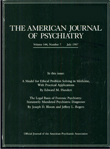Mental Disorders and Disability Among Patients in a Primary Care Group Practice
Abstract
OBJECTIVE: This article examines social and occupational disability associated with several DSM-IV mental disorders in a group of adult primary care outpatients. METHOD: The subjects were 1,001 primary care patients (aged 18–70 years) in a large health maintenance organization. Data on each patient's sociodemographic characteristics and functional disability, including scores on the Sheehan Disability Scale, were collected at the time of a medical visit. A structured diagnostic interview for current DSM-IV disorders was then completed by a mental health professional over the telephone within 4 days of the visit. RESULTS: The most prevalent disorders were phobias (7.7%), major depressive disorder (7.3%), alcohol use disorders (5.2%), generalized anxiety disorder (3.7%), and panic disorder (3.0%). A total of 8.3% of the patients met the criteria for more than one mental disorder. The proportion of patients with co-occurring mental disorders varied by index disorder from 50.0% (alcohol use disorder) to 89.2% (generalized anxiety disorder). Compared with patients who had a single mental disorder, patients with co-occurring disorders reported significantly more disability in social and occupational functioning. After adjustment for other mental disorders and demographic and general health factors, compared with patients with no mental disorder, only patients with major depressive disorder, bipolar disorder, phobias, and substance use disorders had significantly increased disability, as measured by the Sheehan Disability Scale. CONCLUSIONS: Primary care patients with more than one mental disorder are common and highly disabled. Individual mental disorders have distinct patterns of psychiatric comorbidity and disability. (Am J Psychiatry 1997; 154:1734–1740)



